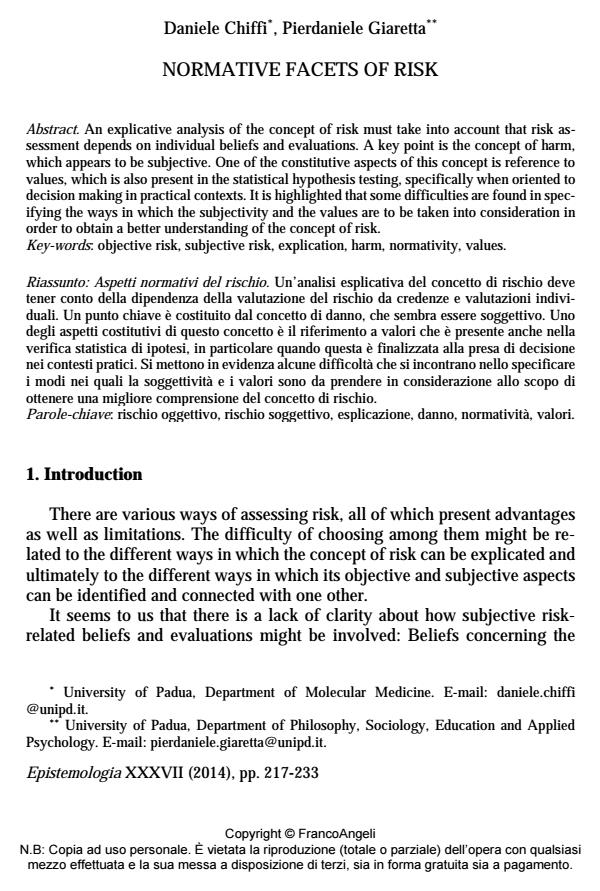Normative facets of risk
Titolo Rivista EPISTEMOLOGIA
Autori/Curatori Daniele Chiffi, Pierdaniele Giaretta
Anno di pubblicazione 2015 Fascicolo 2014/2
Lingua Inglese Numero pagine 17 P. 217-233 Dimensione file 95 KB
DOI 10.3280/EPIS2014-002003
Il DOI è il codice a barre della proprietà intellettuale: per saperne di più
clicca qui
Qui sotto puoi vedere in anteprima la prima pagina di questo articolo.
Se questo articolo ti interessa, lo puoi acquistare (e scaricare in formato pdf) seguendo le facili indicazioni per acquistare il download credit. Acquista Download Credits per scaricare questo Articolo in formato PDF

FrancoAngeli è membro della Publishers International Linking Association, Inc (PILA)associazione indipendente e non profit per facilitare (attraverso i servizi tecnologici implementati da CrossRef.org) l’accesso degli studiosi ai contenuti digitali nelle pubblicazioni professionali e scientifiche
An explicative analysis of the concept of risk must take into account that risk assessment depends on individual beliefs and evaluations. A key point is the concept of harm, which appears to be subjective. One of the constitutive aspects of this concept is reference to values, which is also present in the statistical hypothesis testing, specifically when oriented to decision making in practical contexts. It is highlighted that some difficulties are found in specifying the ways in which the subjectivity and the values are to be taken into consideration in order to obtain a better understanding of the concept of risk.
Un’analisi esplicativa del concetto di rischio deve tener conto della dipendenza della valutazione del rischio da credenze e valutazioni individuali. Un punto chiave è costituito dal concetto di danno, che sembra essere soggettivo. Uno degli aspetti costitutivi di questo concetto è il riferimento a valori che è presente anche nella verifica statistica di ipotesi, in particolare quando questa è finalizzata alla presa di decisione nei contesti pratici. Si mettono in evidenza alcune difficoltà che si incontrano nello specificare i modi nei quali la soggettività e i valori sono da prendere in considerazione allo scopo di ottenere una migliore comprensione del concetto di rischio.
Parole chiave:Rischio oggettivo, rischio soggettivo, esplicazione, danno, normatività, valori.
- Clinical Reasoning: Knowledge, Uncertainty, and Values in Health Care Daniele Chiffi, pp.145 (ISBN:978-3-030-59093-2)
- Risk and Resilience Daniele Chiffi, Simona Chiodo, pp.1 (ISBN:978-3-030-56066-9)
Daniele Chiffi, Pierdaniele Giaretta, Normative facets of risk in "EPISTEMOLOGIA" 2/2014, pp 217-233, DOI: 10.3280/EPIS2014-002003